Nooreestlastest ja rahvaluulest
Noor-Eesti and folklore
Author(s): Ruth MirovSubject(s): Customs / Folklore
Published by: Eesti Kirjandusmuuseum
Keywords: Johannes Aavik; Villem Grünthal-Ridala; Gustav Suits; Friedebert Tuglas; Noor-Eesti; Kalevipoeg; relations between literature and folklore; runic song
Summary/Abstract: The Noor-Eesti (Young Estonia) group, which gradually developed into a literary-culturalmovement, was initiated by Gustav Suits in the early 20th century. Being a gymnasium student at the time, he gathered around himself active nationally-minded young people, some of whom later on became renowned scientists and writers – apart from Suits himself, Friedebert Tuglas, Johannes Aavik and Villem Grünthal-Ridala. In 1905 and 1906 Suits, Aavik and Grünthal-Ridala left for Helsinki to study at university. Besides other courses, they also attended lectures on folkloristics. The young men were supported in their endeavours to study national sciences by Jaan Tõnisson, Chief Editor of the newspaper Postimees (Postman) published in Tartu, as well as Aino and Oskar Kallas, the latter of whom had received his PhD degree in folkloristics at Helsinki University in 1901. Friedebert Tuglas, due to his revolutionary activities, did not complete his studies at university; yet, in 1906 he also left for Finland – as an exile. Folklore achieved a high status in Estonian cultural life from the mid-19th century, in the period of National Awakening, when Friedrich Reinhold Kreutzwald published the national epic Kalevipoeg (Kalev’s Son) and Jakob Hurt started to organise the collection of folklore under the auspices of the Society of Estonian Literati. In 1888 Jakob Hurt initiated extensive collection of folklore through the correspondents’ network, which in the Russification campaign of the last decades of the 19th century became the only nationwide undertaking. Concurrently with Hurt, Matthias Johann Eisen took up folklore collection, and in 1904 Oskar Kallas initiated an extensive campaign for collecting folk music. Due to all this, by the time of the foundation of the Noor-Eesti literary group, folklore had been established in the public mind for nearly half a century and was recognised, especially by the intelligentsia, as one of the pillars of national identity. In the case of Aavik and Ridala the role of folklore in their educational work is also worth mentioning. Besides, the article discusses literary creation based on folklore, in which Ridala was especially prolific, being represented by three voluminous rune poems and a collection of ballads. As they were educated in Finland, their ideal was the Finnish national epic Kalevala, which was based on folk songs, and the form inherent in the Finnish old folk song – the so-called Kalevala verse. They also appreciated highly the Estonian runic verse folk song, which employs the same form principle. The runic song was treated by them as artisticartistically high-level poetry. Proceeding from these stances, they (especially Aavik and Tuglas) criticised the Estonian national epic Kalevipoeg, whereas Aavik and Ridala made attempts to re-versify the epic in an ideal verse form.
Journal: Mäetagused. Hüperajakiri
- Issue Year: 2012
- Issue No: 51
- Page Range: 21-48
- Page Count: 28
- Language: Estonian

